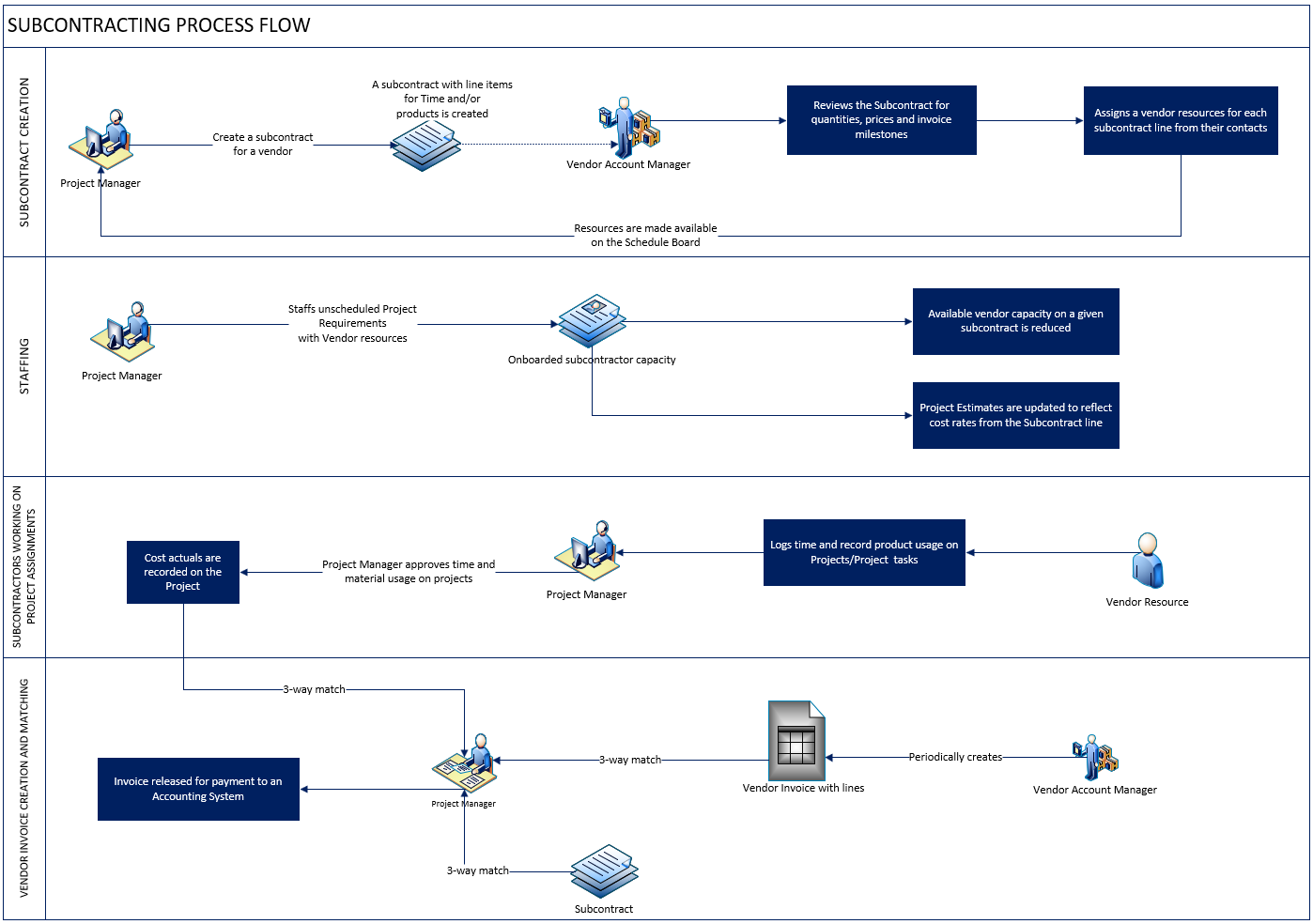Note
Access to this page requires authorization. You can try signing in or changing directories.
Access to this page requires authorization. You can try changing directories.
Applies To: Project Operations Integrated with ERP, Core deployment - deal to proforma invoicing
This article provides an overview of the end-to-end subcontract management process in project-based organizations. Subcontracting for services typically follows the business process flow that is shown in the following diagram.

The following list provides a step-by-step description of the subcontracting process.
The project manager creates a subcontract with a vendor. By default, the price lists that are attached to the vendor record are used for the subcontract. The vendor account has a relationship type of Vendor or Supplier.
The project manager can itemize all the purchases as line items on the subcontract. Subcontract lines can be for time, expenses, or products. The transaction class of the subcontract line determines what the line is for.
The vendor account manager and the project manager can iterate over the subcontract. Pricing can be adjusted in the purchase price lists that are attached to the subcontract.
At this point or later in the process, if the subcontract line is for time, the vendor account manager associates vendor contacts with each subcontract line. This association provides information to the project manager who is working on the subcontract. When a vendor contact is associated with a subcontract line, the system automatically creates a bookable resource from the contact, if a bookable resource doesn't already exist.
The billing method on each subcontract line can be Fixed Price or Time and Material. For fixed-price subcontract lines, a milestone-based invoice schedule is set up.
After the subcontract is set up and the negotiation is complete, it's confirmed. Confirmed subcontracts can't be edited but if changes occur, a subcontract can be ‘reopened for edits', which sets the status from Confirmed back to Draft and negotiation can be reopened.
When you create a generic team member on a project, the team member can be associated to a subcontract line. This indicates the need to staff the generic team member with subcontractor capacity.
Named team members can either be created directly on a project or created by booking them using the resource scheduling experiences. If a named project team member is a contract worker, it’s possible to associate this to a subcontract line. This draws down the available capacity on a subcontract line.
Subcontractor resources can log time, expenses, and material usage on projects and project tasks, and then submit for approval. This is similar for employees. When you record time, a contract worker can select a specific subcontract and subcontract line.
Upon approval, time approved by subcontracts records project cost actuals based on the purchase price of the contract worker or the role they performed on the project.
Vendor invoices and vendor invoice line items can be recorded in the system for the work performed by vendor resources or products delivered by the vendor. Vendor invoice lines must be specific to a project and for a transaction class of time, expense, product/material, milestone, or fee. Optionally, vendor invoice lines can reference a subcontract line.
The system automatically associates all cost actuals that match the subcontract line and project to the vendor invoice. This facilitates a three way match and verification process.
The project manager can then review the automatically matched project actuals, remove or add other project cost actuals, and complete the verification process.
Completing the verification process on all lines marks the vendor invoice as Ready for Payment. At this stage, the vendor invoice and lines can be transferred to an Accounting or Payables system to process the payment to the vendor. Previously recorded project costs are reversed and actual costs from the vendor invoice line are recorded on the project.
Important
Fixed Price subcontracts are currently not supported for resource/non-stocked based scenarios in Project Operations.
Quantity-based subcontract lines and work-based subcontract lines
A subcontract line can be quantity-based or work-based.
When a subcontract line is quantity-based, the quantity being purchased on the subcontract line for time, expense, or material can be used on any project.
When a subcontract line is work-based, the subcontract line maps to a body of work represented by a node in the project plan. The value of the subcontract line is the sum of all the components that are required to deliver that body of work. These are modeled as subcontract line details and can be a collection of time, expense, or materials. For a work-based subcontract line, the subcontract line is also dedicated to a single project. These types of subcontracts are currently not supported by Project Operations.